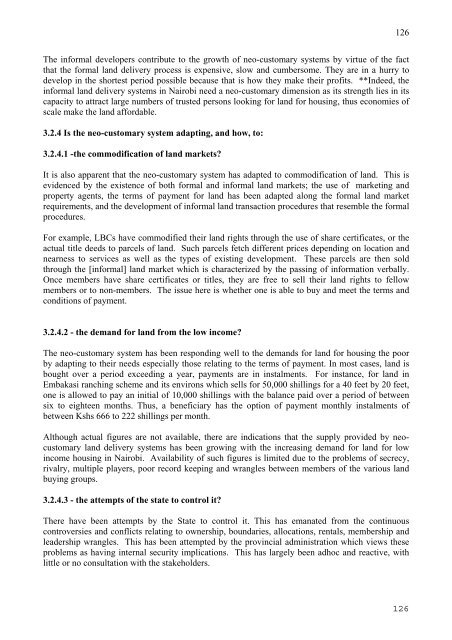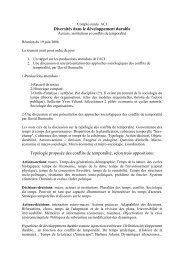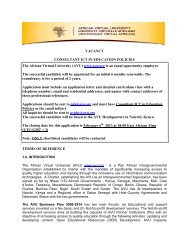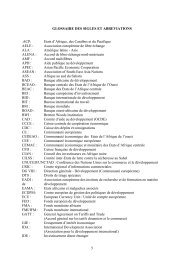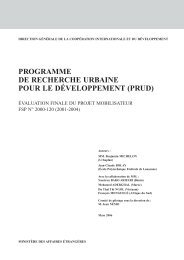You also want an ePaper? Increase the reach of your titles
YUMPU automatically turns print PDFs into web optimized ePapers that Google loves.
126The informal developers contribute to the growth of neo-customary systems by virtue of the factthat the formal land delivery process is expensive, slow and cumbersome. They are in a hurry todevelop in the shortest period possib<strong>le</strong> because that is how they make their profits. **Indeed, theinformal land delivery systems in Nairobi need a neo-customary dimension as its strength lies in itscapacity to attract large numbers of trusted persons looking for land for housing, thus economies ofsca<strong>le</strong> make the land affordab<strong>le</strong>.3.2.4 Is the neo-customary system adapting, and how, to:3.2.4.1 -the commodification of land markets?It is also apparent that the neo-customary system has adapted to commodification of land. This isevidenced by the existence of both formal and informal land markets; the use of marketing andproperty agents, the terms of payment for land has been adapted along the formal land marketrequirements, and the development of informal land transaction procedures that resemb<strong>le</strong> the formalprocedures.For examp<strong>le</strong>, LBCs have commodified their land rights through the use of share certificates, or theactual tit<strong>le</strong> deeds to parcels of land. Such parcels fetch different prices depending on location andnearness to services as well as the types of existing development. These parcels are then soldthrough the [informal] land market which is characterized by the passing of information verbally.Once members have share certificates or tit<strong>le</strong>s, they are free to sell their land rights to fellowmembers or to non-members. The issue here is whether one is ab<strong>le</strong> to buy and meet the terms andconditions of payment.3.2.4.2 - the demand for land from the low income?The neo-customary system has been responding well to the demands for land for housing the poorby adapting to their needs especially those relating to the terms of payment. In most cases, land isbought over a period exceeding a year, payments are in instalments. For instance, for land inEmbakasi ranching scheme and its environs which sells for 50,000 shillings for a 40 feet by 20 feet,one is allowed to pay an initial of 10,000 shillings with the balance paid over a period of betweensix to eighteen months. Thus, a beneficiary has the option of payment monthly instalments ofbetween Kshs 666 to 222 shillings per month.Although actual figures are not availab<strong>le</strong>, there are indications that the supply provided by neocustomaryland delivery systems has been growing with the increasing demand for land for lowincome housing in Nairobi. Availability of such figures is limited due to the prob<strong>le</strong>ms of secrecy,rivalry, multip<strong>le</strong> players, poor record keeping and wrang<strong>le</strong>s between members of the various landbuying groups.3.2.4.3 - the attempts of the state to control it?There have been attempts by the State to control it. This has emanated from the continuouscontroversies and conflicts relating to ownership, boundaries, allocations, rentals, membership and<strong>le</strong>adership wrang<strong>le</strong>s. This has been attempted by the provincial administration which views theseprob<strong>le</strong>ms as having internal security implications. This has largely been adhoc and reactive, withlitt<strong>le</strong> or no consultation with the stakeholders.126


